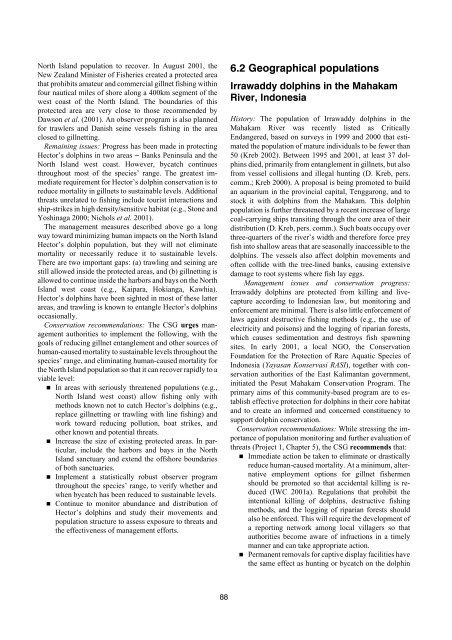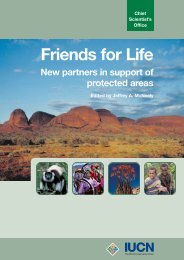Dolphins, Whales and Porpoises: 2002-2010 Conservation - IUCN
Dolphins, Whales and Porpoises: 2002-2010 Conservation - IUCN
Dolphins, Whales and Porpoises: 2002-2010 Conservation - IUCN
You also want an ePaper? Increase the reach of your titles
YUMPU automatically turns print PDFs into web optimized ePapers that Google loves.
North Isl<strong>and</strong> population to recover. In August 2001, the<br />
New Zeal<strong>and</strong> Minister of Fisheries created a protected area<br />
that prohibits amateur <strong>and</strong> commercial gillnet fishing within<br />
four nautical miles of shore along a 400km segment of the<br />
west coast of the North Isl<strong>and</strong>. The boundaries of this<br />
protected area are very close to those recommended by<br />
Dawson et al. (2001). An observer program is also planned<br />
for trawlers <strong>and</strong> Danish seine vessels fishing in the area<br />
closed to gillnetting.<br />
Remaining issues: Progress has been made in protecting<br />
Hector’s dolphins in two areas – Banks Peninsula <strong>and</strong> the<br />
North Isl<strong>and</strong> west coast. However, bycatch continues<br />
throughout most of the species’ range. The greatest immediate<br />
requirement for Hector’s dolphin conservation is to<br />
reduce mortality in gillnets to sustainable levels. Additional<br />
threats unrelated to fishing include tourist interactions <strong>and</strong><br />
ship-strikes in high density/sensitive habitat (e.g., Stone <strong>and</strong><br />
Yoshinaga 2000; Nichols et al. 2001).<br />
The management measures described above go a long<br />
way toward minimizing human impacts on the North Isl<strong>and</strong><br />
Hector’s dolphin population, but they will not eliminate<br />
mortality or necessarily reduce it to sustainable levels.<br />
There are two important gaps: (a) trawling <strong>and</strong> seining are<br />
still allowed inside the protected areas, <strong>and</strong> (b) gillnetting is<br />
allowed to continue inside the harbors <strong>and</strong> bays on the North<br />
Isl<strong>and</strong> west coast (e.g., Kaipara, Hokianga, Kawhia).<br />
Hector’s dolphins have been sighted in most of these latter<br />
areas, <strong>and</strong> trawling is known to entangle Hector’s dolphins<br />
occasionally.<br />
<strong>Conservation</strong> recommendations: The CSG urges management<br />
authorities to implement the following, with the<br />
goals of reducing gillnet entanglement <strong>and</strong> other sources of<br />
human-caused mortality to sustainable levels throughout the<br />
species’ range, <strong>and</strong> eliminating human-caused mortality for<br />
the North Isl<strong>and</strong> population so that it can recover rapidly to a<br />
viable level:<br />
� In areas with seriously threatened populations (e.g.,<br />
North Isl<strong>and</strong> west coast) allow fishing only with<br />
methods known not to catch Hector’s dolphins (e.g.,<br />
replace gillnetting or trawling with line fishing) <strong>and</strong><br />
work toward reducing pollution, boat strikes, <strong>and</strong><br />
other known <strong>and</strong> potential threats.<br />
� Increase the size of existing protected areas. In particular,<br />
include the harbors <strong>and</strong> bays in the North<br />
Isl<strong>and</strong> sanctuary <strong>and</strong> extend the offshore boundaries<br />
of both sanctuaries.<br />
� Implement a statistically robust observer program<br />
throughout the species’ range, to verify whether <strong>and</strong><br />
when bycatch has been reduced to sustainable levels.<br />
� Continue to monitor abundance <strong>and</strong> distribution of<br />
Hector’s dolphins <strong>and</strong> study their movements <strong>and</strong><br />
population structure to assess exposure to threats <strong>and</strong><br />
the effectiveness of management efforts.<br />
88<br />
6.2 Geographical populations<br />
Irrawaddy dolphins in the Mahakam<br />
River, Indonesia<br />
History: The population of Irrawaddy dolphins in the<br />
Mahakam River was recently listed as Critically<br />
Endangered, based on surveys in 1999 <strong>and</strong> 2000 that estimated<br />
the population of mature individuals to be fewer than<br />
50 (Kreb <strong>2002</strong>). Between 1995 <strong>and</strong> 2001, at least 37 dolphins<br />
died, primarily from entanglement in gillnets, but also<br />
from vessel collisions <strong>and</strong> illegal hunting (D. Kreb, pers.<br />
comm.; Kreb 2000). A proposal is being promoted to build<br />
an aquarium in the provincial capital, Tenggarong, <strong>and</strong> to<br />
stock it with dolphins from the Mahakam. This dolphin<br />
population is further threatened by a recent increase of large<br />
coal-carrying ships transiting through the core area of their<br />
distribution (D. Kreb, pers. comm.). Such boats occupy over<br />
three-quarters of the river’s width <strong>and</strong> therefore force prey<br />
fish into shallow areas that are seasonally inaccessible to the<br />
dolphins. The vessels also affect dolphin movements <strong>and</strong><br />
often collide with the tree-lined banks, causing extensive<br />
damage to root systems where fish lay eggs.<br />
Management issues <strong>and</strong> conservation progress:<br />
Irrawaddy dolphins are protected from killing <strong>and</strong> livecapture<br />
according to Indonesian law, but monitoring <strong>and</strong><br />
enforcement are minimal. There is also little enforcement of<br />
laws against destructive fishing methods (e.g., the use of<br />
electricity <strong>and</strong> poisons) <strong>and</strong> the logging of riparian forests,<br />
which causes sedimentation <strong>and</strong> destroys fish spawning<br />
sites. In early 2001, a local NGO, the <strong>Conservation</strong><br />
Foundation for the Protection of Rare Aquatic Species of<br />
Indonesia (Yayasan Konservasi RASI), together with conservation<br />
authorities of the East Kalimantan government,<br />
initiated the Pesut Mahakam <strong>Conservation</strong> Program. The<br />
primary aims of this community-based program are to establish<br />
effective protection for dolphins in their core habitat<br />
<strong>and</strong> to create an informed <strong>and</strong> concerned constituency to<br />
support dolphin conservation.<br />
<strong>Conservation</strong> recommendations: While stressing the importance<br />
of population monitoring <strong>and</strong> further evaluation of<br />
threats (Project 1, Chapter 5), the CSG recommends that:<br />
� Immediate action be taken to eliminate or drastically<br />
reduce human-caused mortality. At a minimum, alternative<br />
employment options for gillnet fishermen<br />
should be promoted so that accidental killing is reduced<br />
(IWC 2001a). Regulations that prohibit the<br />
intentional killing of dolphins, destructive fishing<br />
methods, <strong>and</strong> the logging of riparian forests should<br />
also be enforced. This will require the development of<br />
a reporting network among local villagers so that<br />
authorities become aware of infractions in a timely<br />
manner <strong>and</strong> can take appropriate action.<br />
� Permanent removals for captive display facilities have<br />
the same effect as hunting or bycatch on the dolphin






